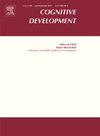The development and predictors of school-age children’s nonsymbolic number comparison abilities: Modulated by congruency between numerosity and visual cues
IF 1.8
3区 心理学
Q3 PSYCHOLOGY, DEVELOPMENTAL
引用次数: 0
Abstract
Children’s abilities to compare two sets of nonsymbolic numbers improve throughout development. However, it remains unclear whether the improvement is driven by a more precise internal representation of numerosity or an enhanced ability to resist interference from visual cues. To address this question, we conducted a one-year longitudinal study with 112 children (Mage = 8 years and 9 months, SD = 7 months at T1), comparing performance changes in two conditions — the numerosity and visual cues of the nonsymbolic sets were either congruent (e.g., the more numerous dot set has larger dot sizes) or incongruent (e.g., the more numerous dot set has smaller dot sizes). Besides, to better understand the cognitive mechanism underlying improvements in nonsymbolic number comparison, we compared the predictors of performance changes in both conditions. We found significant improvement in children’s performance on the incongruent condition but not the congruent condition. Working memory and symbolic numerical magnitude representation predicted changes in the congruent condition, while cognitive flexibility predicted changes in the incongruent condition. These findings suggest that the development and predictors of children’s nonsymbolic number comparison abilities are modulated by the congruency between numerosity and visual cues. For children aged 8–10, improvements in nonsymbolic number comparison abilities are mainly driven by the increasing ability to resist interference from visual cues.
学龄儿童非符号数比较能力的发展及其预测因素:由数字与视觉线索的一致性调节
儿童比较两组非符号数字的能力在整个发展过程中不断提高。然而,目前尚不清楚这种改善是由更精确的内部数字表示还是增强的抵抗视觉提示干扰的能力所驱动的。为了解决这个问题,我们对112名儿童进行了为期一年的纵向研究(年龄= 8岁零9个月,SD = 7个月),比较了两种情况下的表现变化——非符号集的数量和视觉线索要么是一致的(例如,越多的点集具有更大的点大小),要么是不一致的(例如,越多的点集具有更小的点大小)。此外,为了更好地理解非符号数比较的认知机制,我们比较了两种情况下表现变化的预测因子。我们发现儿童在不一致条件下的表现有显著提高,而在一致条件下没有显著提高。工作记忆和符号数量级表征预测了一致条件的变化,认知灵活性预测了不一致条件的变化。这些发现表明,儿童非符号数比较能力的发展及其预测因素是由数字与视觉线索之间的一致性调节的。8-10岁儿童非符号数比较能力的提高主要是由于抵抗视觉提示干扰能力的增强。
本文章由计算机程序翻译,如有差异,请以英文原文为准。
求助全文
约1分钟内获得全文
求助全文
来源期刊

Cognitive Development
Multiple-
CiteScore
3.20
自引率
5.60%
发文量
114
期刊介绍:
Cognitive Development contains the very best empirical and theoretical work on the development of perception, memory, language, concepts, thinking, problem solving, metacognition, and social cognition. Criteria for acceptance of articles will be: significance of the work to issues of current interest, substance of the argument, and clarity of expression. For purposes of publication in Cognitive Development, moral and social development will be considered part of cognitive development when they are related to the development of knowledge or thought processes.
 求助内容:
求助内容: 应助结果提醒方式:
应助结果提醒方式:


